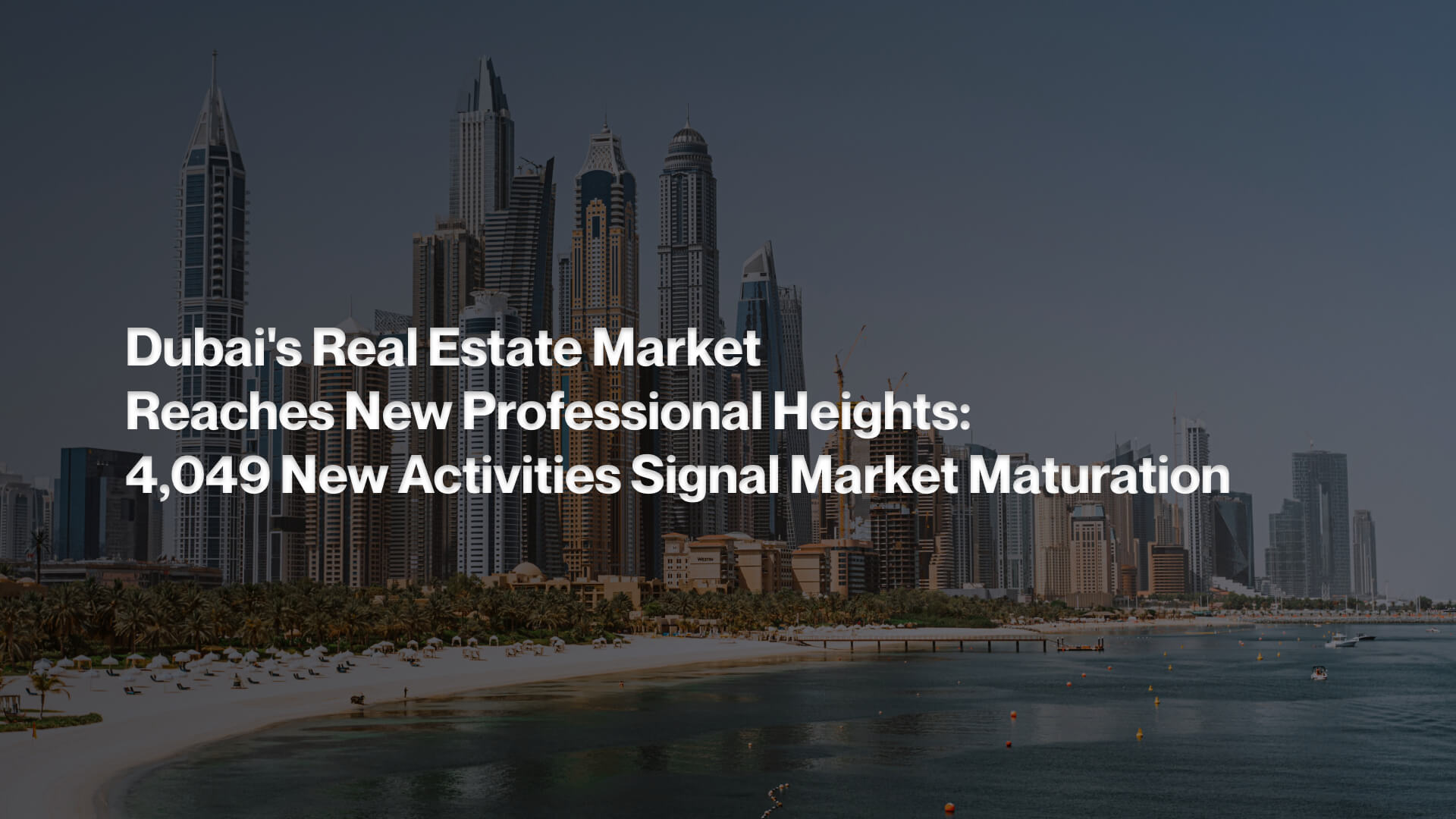
Market Evolution Beyond Numbers
Dubai's real estate sector has registered 4,049 new licensed activities in the first half of 2025, marking a significant milestone in the emirate's journey toward becoming the world's premier real estate investment destination. This growth represents far more than statistical expansion—it signals the emergence of a mature, professionally-driven market ecosystem built on transparency and regulatory excellence.
The surge in professional registrations coincides with Dubai's continued attraction of international capital, with record-breaking transaction volumes throughout 2024 and into 2025. This growth is underpinned by the Dubai Land Department's (DLD) advanced digital regulatory framework, centered around the Trakheesi System, which directly supports the ambitious Dubai Real Estate Strategy 2033.
Breaking Down the Professional Landscape
The H1 2025 data reveals a comprehensive expansion across all segments of real estate services:
Core Market Services
- Real Estate Sales Brokerage: 2,301 new registrations
- Leasing Brokerage Services: 1,279 new registrations
- Land and Property Trading: 273 new registrations
Specialized Professional Services
- Property Management Supervision: 43 new registrations
- Mortgage Brokerage: 43 new registrations
- Real Estate Consultancy: 40 new registrations
- Property Management Services: 33 new registrations
- Property Valuation Services: 14 new registrations
- Real Estate Development: 11 new registrations
- Jointly Owned Property Management: 9 new registrations
- Mortgage Advisory Services: 3 new registrations
Market Fundamentals: Service-Driven Growth Over Speculation
The data reveals a crucial market dynamic: the registration of 2,301 sales brokerage licenses compared to just 273 trading licenses—a ratio of approximately 8.5 to 1. This disparity is significant, as trading licenses typically serve entities buying and selling for their own account (potentially speculative), while brokerage licenses serve professionals facilitating client transactions.
This structure demonstrates that current growth is driven by a client-centric, service-oriented model rather than speculation—a characteristic of mature global real estate markets that promotes stability and long-term investor confidence.

The Trakheesi System: Digital Foundation for Market Integrity
The growth has been enabled by an advanced regulatory framework that promotes smooth conduct of real estate activities and strengthens market transparency. The Trakheesi system serves as the DLD's official electronic platform for registration, licensing, and permitting of all real estate activities and advertisements.
Key Features:
- Mandatory Registration: Required for all core activities including brokerage, management, and valuation
- Verification System: Every licensed entity receives a unique, verifiable permit number
- Real-Time Transparency: Instant verification capabilities through DLD's website and Dubai REST mobile app
- Integrated Ecosystem: Seamlessly connected with other DLD platforms including Mollak, Ejari, and the Green List
This comprehensive digital infrastructure provides Dubai with a competitive advantage over many global markets, offering investors unprecedented transparency and security.
Alignment with Dubai Real Estate Strategy 2033
The professional growth directly supports key pillars of the Dubai Real Estate Strategy 2033:
Strategic Objectives Being Advanced:
- Enhanced Transparency & Governance: Centralized data and reduced speculation risk
- Technology Integration: AI deployment and seamless digital experiences
- Sectoral Growth: Building capacity to double real estate's GDP contribution to AED 73 billion
- Global Investment Hub: Attracting international capital through world-class professional infrastructure
Market Implications for Investors
The professionalization wave creates several key advantages:
For Individual Investors:
- Reduced Risk: Comprehensive verification systems eliminate fraudulent activities
- Better Service: Expanded network of licensed professionals improves market access
- Informed Decisions: Enhanced data transparency supports better investment choices
For Institutional Capital:
- Regulatory Confidence: Robust legal framework meets international standards
- Professional Support: Specialized services cater to complex investment requirements
- Market Stability: Service-driven growth model reduces speculative volatility
The Path Forward
The 4,049 new professional registrations represent the foundational infrastructure necessary to support the Strategy 2033's ambitious targets, including a 70% increase in transaction volumes. This capacity building ensures the market can handle future growth while maintaining quality and transparency standards.
The evidence points to a virtuous cycle: visionary government planning drives advanced regulatory technology, which fosters professional growth, creating unprecedented transparency that builds investor trust and attracts global capital—fueling sustainable market expansion.
Conclusion
Dubai's real estate market is transitioning from rapid growth to strategic maturation. The H1 2025 professional registration surge confirms the emirate is not just building properties—it's constructing a resilient, globally competitive real estate ecosystem.
For investors, this evolution represents a fundamental shift from speculative timing to strategic, data-driven decision-making in an increasingly transparent market. The systematic engineering out of opacity and regulatory gaps creates unprecedented opportunities for those who can navigate this sophisticated landscape with expert guidance.
As Dubai continues this trajectory toward 2033, the most valuable asset for investors is not just capital, but partnership with professionals who understand and can leverage this new paradigm of transparency, regulation, and sustainable growth.
This analysis is based on official data from the Dubai Land Department and related government sources. For personalized investment guidance in Dubai's evolving real estate market, consult with licensed professionals who understand the regulatory landscape and market dynamics.